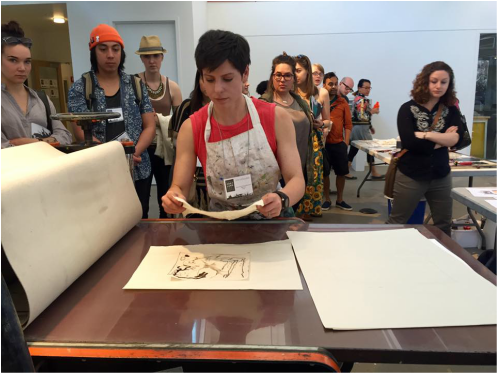Teaching Philosophy
My role as a teacher is to not only present students with the technical and aesthetic information necessary in the creation of art but to encourage them to develop as independent artists. In the classroom, I strive to achieve this through a balancing of objective goals and assignments with an open dialogue. I make accessible to my students the physical tools and materials needed to make art along with an understanding of the concepts of art all to promote personal growth. As a teacher it is not enough to be merely instructive but you must be engaging, and thought provoking. Provide the essentials but inspire to go beyond the basic.
To fully develop as artists, students must be able to dialogue with other artists and problem solve. It is key for them to learn not only methods and processes involved in artistic creation but also to build their verbal skills in the assessment of artwork. Communication of an artistic concept allows the transformation of that idea into a well-developed work. If a student’s artistic vocabulary is lacking so then is their ability to look at others and their own work constructively and assess the success of the piece. With this in mind, students are given clear feedback and constructive criticism in order to establish the effectiveness of an assignment and to encourage their own ability to offer such criticism.
Foundation courses are essential to giving students their communication skills, and building their comfort and confidence in a critique setting. These classes help shape their perspective on what is a successful work of art and gives them the ability to problem-solve. To facilitate a better understanding in foundation classes, each assignment, while having its own concepts to explain, also builds upon and is used to inform consecutive ideas learned within the class. For beginning students, more restrictive guidelines are necessary to work within until they develop the skill level to create more independently. With that in mind I encourage more advanced students to investigate their own inquires absent of a strong guiding hand. I offer advice but allow their voice to emerge.
I strive to create an environment that is open to incorporate new ideas and processes. There must be a balance of traditional and contemporary tools to allow students not only to develop creatively but also to adapt as artists in our current society of fast-paced technology. By combining the foundation of a traditional art education with an emphasis on technically sound execution, and a contemporary dialogue with more modern tools, I hope to help the students become more relevant artists in today’s society.
To fully develop as artists, students must be able to dialogue with other artists and problem solve. It is key for them to learn not only methods and processes involved in artistic creation but also to build their verbal skills in the assessment of artwork. Communication of an artistic concept allows the transformation of that idea into a well-developed work. If a student’s artistic vocabulary is lacking so then is their ability to look at others and their own work constructively and assess the success of the piece. With this in mind, students are given clear feedback and constructive criticism in order to establish the effectiveness of an assignment and to encourage their own ability to offer such criticism.
Foundation courses are essential to giving students their communication skills, and building their comfort and confidence in a critique setting. These classes help shape their perspective on what is a successful work of art and gives them the ability to problem-solve. To facilitate a better understanding in foundation classes, each assignment, while having its own concepts to explain, also builds upon and is used to inform consecutive ideas learned within the class. For beginning students, more restrictive guidelines are necessary to work within until they develop the skill level to create more independently. With that in mind I encourage more advanced students to investigate their own inquires absent of a strong guiding hand. I offer advice but allow their voice to emerge.
I strive to create an environment that is open to incorporate new ideas and processes. There must be a balance of traditional and contemporary tools to allow students not only to develop creatively but also to adapt as artists in our current society of fast-paced technology. By combining the foundation of a traditional art education with an emphasis on technically sound execution, and a contemporary dialogue with more modern tools, I hope to help the students become more relevant artists in today’s society.
